Fundamentalist Christians and its Wrong Approach to Spiritual Teachings (22):

Occultism and Post-awakening Natures:
.

.
.
Dancing in the Sliding Scales of Ideals [Posted initially on 23rd May 2021]: Refers to the natural processes of our amorphic cultural descent – It’s a dance because as much as we know what is going on, we can’t dismiss the fact that there is this other ‘thing’ attached to the effect of those movements. Take, for instance, the very unrestrained and politically correct [woke-isim] barrage on the entertainment industry, notably on writers and directors who must balance their artistic integrity against an agenda. An agenda is run by a group that thinks they know what ethically correct ideals are. And we know ethics without debate is ethically unsound, and we know there is confusion towards ethics with morality. However, most of the social issues being brought up by woke-is still need to be addressed with some restraint; otherwise, it’s a recipe for disaster.
Ethics doesn’t pay; for example, social security’s socialist model is always tunnelled through a managerial no-win situation. Following the rule in bureaucratic ethical policy, not setting yourself up for fraud imposes the other for disclosure of personal information. When denied, it’s cancelled [meaning you don’t get paid]. The ever-prevailing maritime law juxtaposed with natural law, the latter chooses to see the value in people, not as an individual of the land but as a corporation and authority built upon people’s consent. It relies on ignorance and false memory files to impose fake referents of the word. By defining man as a person, a person is a corporation, and man is not. This system doesn’t benefit the individual; liabilities are disguised as benefits.
Recognising ethics as a serious matter is appropriate around any subject that implores debate, such as the death penalty and feeding the poor. Socialists often use ethics as their talking point, but ethics usually doesn’t pay because it’s not utilitarian. Ethics doesn’t pay in so much as you’re dammed if you do; dammed if you don’t. It parallels entertainment groups with a lot to lose and is then brought down, knowing that if groups go woke, they’ll go broke, or if they don’t, they’ll still go broke. Both are a gamble, but one has a chance of a sure thing, while the other is doomed from the get-go.
Woke-isim acts on Strindberg’s quote, “Kindly control your imagination …That is what makes men beasts” – although they’re not identifying the fear of uncertainty. They are, instead, controllers of your imaginations, a politically (in)correct meme virus with an agenda. The assumption is that creativity can be bottled and manufactured like a factory process line. We first had glimpses of this when rationalists or scientifically minded worldviews were introduced to creativity as an approach to that creative process. And we know it’s not science because science is pedantic; this is quasi-science [science-fiction] – the fictional aspect acts as a small window for the imagination inside an infinitely vast universe, but we know that the vast universe is just the backdrop for the imagination.
And we know there is a version of science outside science fiction, but it is still science fiction or scientism. This is where the new atheists and rationalists established their religion, but it’s failing, and I believe this was due to the flat-earth movement infamously having had an impact. This version of scepticism, which is unhealthy, had morphed into the woke-movement groups. Given how sceptics and Atheists have been recruiting geeks to their cause, it gave the first clue to creativity being hijacked by the imposition of identity politics. This seems essential in the media realm, but outside of it’s just something to laugh about or laugh away.
There is an argument suggesting mixing science with mysticism is a bad idea, but perhaps this mutual exclusivity can only be definitive in a way that matches the notion of anti-oneness proposition – given it’s a fact outside sensory perceptions are being given to us. Science’s mysticism aspect is Scientism because they’ve taken the icons of gods and reduced them to a satellite cosmos with all the made-up laws they’ve adopted. A more accurate distinction is perhaps not mixing science that requires tests, evaluations and results with mysticism but mysticism that is more in tune with superstition.
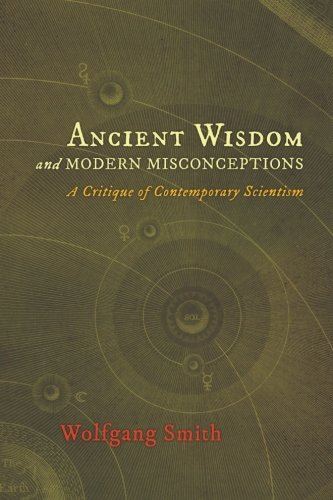
A rock may not have spirit as an animist might view it, but it may have vibrational frequencies that keep it static and impenetrable. At the same time, Niels Bohr declared: “There is no quantum world; there is only a quantum description.” How does one acquire memory files or states of consciousness for the quantum world? We can only give theoretical qualities [referent]. It’s asking for faith, which is religious.
Spiritual science conveys liberal subjects, such as literature, music, etc., as physical science. Then, spiritual materialism came about to identify that there is an all-pervading spirit underlining various forms of phenomena. It’s the categorisation of where the identity of the spirit or psyche functions instead of mere brain functions like spiritual materialism.
When science fiction or pseudo-science (often called scientism) goes beyond narrative entertainment, it can become a form of manipulation. Actual science can be seen as visionary and mystical art, much like the contributions of Newton and Tesla. They have illuminated concepts such as the electromagnetic field surrounding us, reinforced by the ley lines notably found in the pyramids of Egypt. This process has become an idolatry symbol for the imposition of pseudo-scientific principles in real life, like the innumerable concepts of satellization. At the same time, in this weird paradox, satellization acts the same way as myth-makers, but narrow in its imagination, but infinite in its backdrop [the endless universe]. From the likes of Kaku, who identified that string theory mirrors the concepts of Zohar and Kabbala, Maybe so. Still, the result is always reductionist as the mysteries gave it more personality.
What is missing is Jung’s concept of psycho-spiritual-transformations, what he calls [possibly incorrect spelling: ‘enantiodromia’ process], which has similarity with the spiritual-awakening-process, which nobody knows what to do with when it strikes. It’s about being aware that creativity is the result of what is around and inside us and how it penetrates the human essence, resulting in awareness that man is the creator of spirit and that he possesses it. And so this brings us to those with great imaginings, what Schopenhauer describes as the one: ‘who is endowed with imagination as able, as it were, to call up spirits’ These are the artist-prophets that sit at the highest mountain, whose contributions had an impact on culture and society. Schopenhauer also concluded that exact quote that can best describe the dichotomy I’m talking about: ‘Therefore the man without imagination is related to him, as the mussel fastened to its rock’ the producer by numbers, the committee and now with woke-isim is the man without imagination and is there waiting for those with great imaginings to come down from their mountain.
Woke-isim may have grown out of sceptics and new-Atheism, given that its process of thinking is similar, so one can conclude that this is indeed the case. Although woke-isim acts more like a decompiling virus, I believe the notion of identity politics originated in Christian theology with a focus on eschatology, the idea that ‘the marginalised will triumph at the end and the kingdom of heaven.’ Woke’s new label as Puritan can only support that claim. The contention argument, or perhaps the elite’s, recognised that and concluded there was no way it would happen, so they employed these woke-puritans to even it out. The theory that it may originate from a far-right totalitarian group is evident in their tendency to downplay a radical racial movement.
Woke’s ideological simplicity and Fundamentalism’s ideological absolutes and absolutism are both recipes for disaster. Still, only one seems to be a permanent constant because it attaches itself to a timeless myth. You could argue that absolute ideology came to light due to how biblical literature is parsed, but that would assume that Christians can’t distinguish what the Holy Book said at that time from how people live their lives now. Given what memory is and how memory acts, there must be a benefit of the doubt.
Evangelicalism, outside conspiracy theories or political agendas, is similar to traditional Christians. Attempt to manage the creative-imaginative process through Evangelical filters. This means a Christianized imitation of some secular genre or style. Christian sports stories, Christian detective stories, Christian sex manuals, Christian heavy metal, and Christian self-help books – it’s all second-hand recycling of old mainstream ideals. These are all pretty much stale in comparison – this is due to how linear Evangelicalism is when it communicates – with the immense pressure to conform to authority, it destroys the creative process. This is insidious, but it’s within its bubble where creativity is stifled as managed creativity starts at the roots. Meanwhile, woke is parasitic and attaches to creative ideas that have already been fully realised, which is far-reaching. Evangelicalism wants this but doesn’t have this kind of reach, and it only reinforces my speculation.
Their linear perspective doesn’t allow a means for better communication. The need to conform and submit to authority is a habit that diminishes any creativity an Evangelical might have. The outcome will always be derivative. There is a habit of discouraging individual thought, ironically promoting individuality as a staple of right politics. However, outside of Evangelicalism and conspiracy theory, the same sorts of debasement happen even amongst creatives outside the shackles of biblical authority, but adhere instead to a corporation, and in some ways, can be a modern marginalization of the imagination.
If woke-isim is indeed an offshoot of (atheism) scepticism, reductionism, and rationalism, where does that leave intuition and imagination? It’s as oppressive as the Evangelical filters. It points to the notion that secularism can lead to nihilism. In the last post, we discussed the process of Vitvan’s general semantics, which is about images and feelings appearing as substantive, heading towards synthesis rather than oneness. This makes woke-isim a repellent to general semantics because woke is a process in reductionism that doesn’t grasp complete synthesis.
As opposed to being woke, the awakening realises that they have awakened to a simulated world and, to go deeper, a holographic world. This event creates many existential dilemmas about reality. The film I Heart Huckabees is about a group that hires existential detectives to solve their existential problems. Albert hires them to solve his coincidences, whether they are insignificant or meaningful.

Albert’s ark goes from being superficial to nihilism to self-actualization. His coincidences [represented in an African door-man] would lead him into a Christian home where the Sudanese man lives as a home-stay. This is the film’s subtle way of showing his self-actualization would lead him to Christianity. Given how Christianity [perhaps not faith itself] in some ways can be secular … and in light of awakening to a world that is simulated and driven by reductionism. His self-actualization, his synthesis leading into oneness … is that his coincidences lead him into spirituality. There is also something to be said about existential detectives that can be surmised more profoundly as of-shoots of synchronistic mystics.
Earth-Image and Evolution-idolatry Cyphered through General Semantics: Christian fundamentalism is also an off-shoot of those ‘men without imagination’. The theist sects implore or even support the satellization cosmos as well as the wrong aspects of evolution. In the last post where, we outline Vitvan’s general semantics about restraining from using words/images with no proper referent has been established. And it would be from traditional Christian fundamentalist Kent Hovind that took this process or tool [unknowingly] and recognized that the images that were used to convey many of (Darwin’s) evolution fallacy.
The tool for this awareness [Vitvan’s Semantics] can usually be challenged by groups with an agenda who are aware by giving false references, which means they can establish a false absolute. Evolution and its notable subject, natural selection, turned out to be … in one particular sense, not the cause of evolution but ensures the bad ones don’t survive. However, it won’t change into something else entirely, and a more definitive word to use is variation. Embryo development identifies gills in the embryo cells; this is incorrect. They are the proto-growth for the ears and throat and have nothing to do with breathing. Haeckel illustrated these fake drawings in 1874; however, Haeckel’s assumptions are wrong and proven as such as actual photos became evident, although his drawings were still used in educational textbooks until the latter part of 1999 (not sure of the present time).
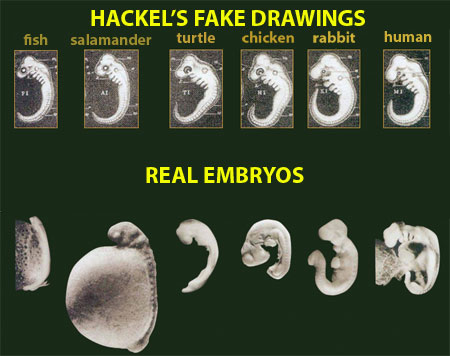
Hackel’s attempt at a false-to-fact abstraction coincides with the hyperreal space’s attempt to create a fake universe map when the map is not the territory. Akin to Baudrillard’s fable, only in his view, is the map, the simulacrum that has meaning but, as a model, loses all reference to reality. Hackel’s fake image (illustrations) is not the label, the reference, or the referent. And it’s an attempt to be all of those through hyperrealism, through the simulated.
A simulated hyperreal space where Earth’s image blends various data sets from multiple instruments into one picture, and a notable person in charge of this is (NASA’s) Rob Simmons. He says, “It is photo-shopped …but it has to be,” and so this is where one set of suspicions lies, hoaxes (moon landings and space travels) act as a simultaneous ‘false and real’ referent or reference when all they have is the false Label. This leaves us with a hyperreal-space notion. Space shuttles and rocket take-offs are accurate to a point they are not; our inability to pass a certain point is halted by something unimaginable to human understanding.
Scientists don’t know where all matters come from, where the laws came from, where the energy came from. Also, the notion that is the conservation of angular momentum (if the universe began in a swirling dot), why do two planets spin backward? (Venus, Uranus, and possibly Pluto rotate backward from other planets). Six of the 63 moons rotate backward: Jupiter, Saturn, and Neptune. Intelligent people have concluded that scientism (not science itself) is a religion because it asks for you to believe. So, the same can be said for the majority of what Evolution advocates. The dialectical argument of believing God created heaven and earth 6000 thousand years ago to that of life stemming from a rock or a pool 4.6 billion years ago. The many assumptions of different species having common ancestors are thereby differentiated by the many original species it has in common. This is another example of a secular argument assuming materialism for the argument that the many different species of birds that Darwin found in the Galapagos Islands have a common ancestor, and that ancestor is still the Bird. The many species of birds cannot be equated (or related) to something different entirely, and they are just mere variations.
The fallacy of fossils is that such evidence cannot determine related species and that all the ancestors are, therefore, determined by bones, and within that inclusion of false to-fact reference that certain animals back then could do something that animals of today can’t. Steven Gaul states, “The absence of fossil evidence for any immediate stages is a persistent and nagging problem for evolution” They can look for the missing links as long as they wish, but how do you find something that doesn’t exist?
The fallacy of carbon dating ascribes to assumptions, and so, therefore, is unreliable, using Kent Hovind’s analogy of a burning candle; if someone were to come across a burning candle and another person asks, ‘When was the candle lit? It’s undetermined, as the candle was burning before he got there. Through empirical science, the candle’s height and rate of burn of one inch per hour are determined by the burn rate, but the fire in which it was lit is still being determined unless you are willing to make assumptions. So, you can determine the amount […] this can be measured and the decay rate, but that is all. How much […] was in it at death and whether or not the decay rate has been constant are not provable. Samples of known-age Radioisotope dating don’t work, while samples of unknown-age Radioisotope dating are assumed to work.
Iconoclasm; Cyphered through General Semantics: When talking about intent and symbolism [images], it becomes a grey area because the symbols become their own stories once it’s in motion. Symbols are part of a program on several levels, in our conscious and unconscious minds, DNA, and culture. Sure, a designer might be exploring with symbolism or has an allegory to tell, but it’s all very nebulous. You can try to be methodical, but more often than not, it’s a recycling of an image. There is only one way to draw a square, triangle, and circle. Then, there is the aspect where the symbolism creeps in because the artist is playing with themes and finds himself being pulled under. Symbols start to tell their own stories; the symbols activate the part of the brain you didn’t even know was being activated.
A symbol taking on its form and stories can be hijacked if its true intent has been dormant for millennia, like the Swastika symbol. This is a heresy [reject the image’s meaning, but keeps the image] for another label to define a false referent. The Swastika was adopted and inverted to corrupt its symbolic meaning, and the term ‘Aryan’ has a sinister history since the Nazis used it for their idea of the ‘chosen’ people being the German race. The original term ‘Aryan’ is mentioned in the Indian sacred books, the Vedas. ‘Aryan’ alludes to the wise men, the rishis or seers of northern India. It was later redefined by the Orientalists who have made ‘Aryans’ of all Europeans. The Nazi writers then adopted the word and redefined it to mean the German race. Extreme right-wing groups have also been found to use the term “Aryan race” to mean the white race; the national alliance, a right-wing group, adopted the term ‘natural order’ to convey their idea of the position of the white race.
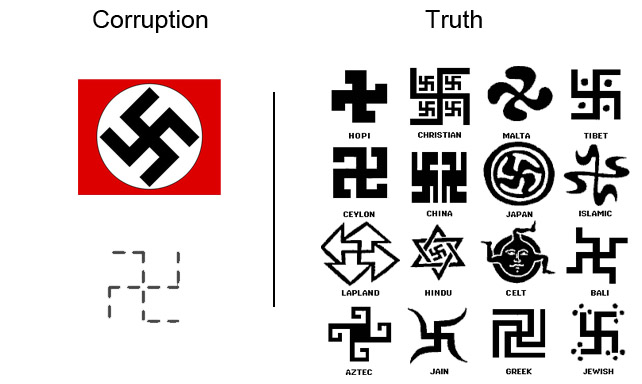
This confusion of meaning arises in people’s minds and thoughts, and they need to realise what Blavatsky’s definition of such a notion means: ‘type of consciousness, ‘principle of consciousness to be developed’, etc., and not that of skin colour. Indians view this connotation as something to be admired as it is part of their Vedic terminology, as opposed to the racist one. The corruption of this symbolic meaning has been finger-pointed to theosophy; however, it was Jorg Lanzvon Liebenfels, who is a Nazi writer to a large extent, responsible for this denigration of ancient symbols and scriptures. He is responsible for developing the movement of ariosophy, a debased version of theosophy. They’re responsible for the debased version of Friedrich Nietzsche’s term “Ubermensch”
The first capital city of Sumerians was called ‘Ur’ by the Chaldeans. The surrounding area also encompassed Akkadian, Babylonian, and Assyrian at around 4000 B.C. Sumerians was an important city that spread the basis of many global technologies. An example is the written language, which took the form of iconographic writing [cuneiform] – notice the words icon and graphic coming out of ‘iconographic,’ a series of lines creating pictographs. Then, it was replaced by the Phoenician alphabet [some icons have similarities with the English alphabet] near the neo-Syrian empire.
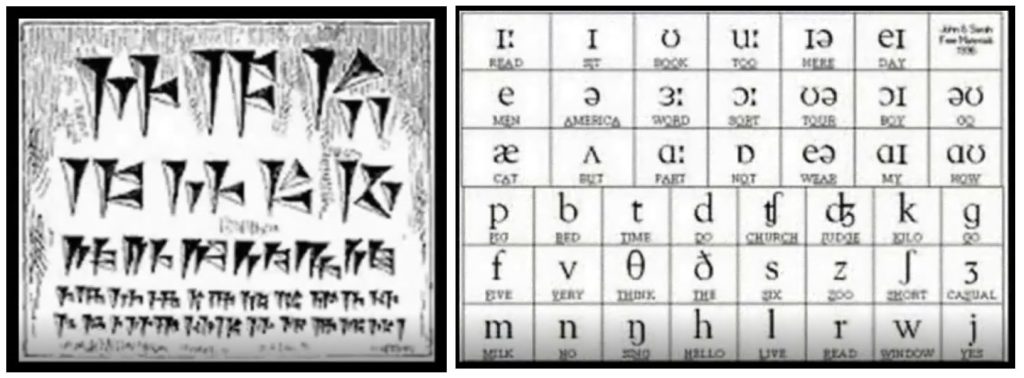
In the Fertile Crescent [cradle of civilisations spanning Iraq, Syria, Lebanon, Israel, Jordan, and Egypt] in the Neolithic times arose humanity’s early form of religion. Mesopotamia [Iraq] is the land between two rivers, Euphrates and Tigris; those two rivers meet together to the south near Basra, called the city Gurney. In this place, there was a Garden of Eden and a Tree of Worship; the Tree was called Adam-Tree. In light of the flat earth and one’s intuitive component, the Garden of Eden and Tree representation are symbolic alters for the sacred centre.
As we know, the Phoenician people [sea-people] were remnants of Atlantis civilisations, and the location of the city of Atlantis has been debated. Still, I believe it to be the once fertile area, the concentric island located in the North. The Atlantians (or Phaeacians) worshipped their central pillar, which has cosmological value to the Polaris Star [tail end of little bear constellation] in conjunction with Ursa Major [great-bear], which makes a swastika symbol. This symbol depicts the four seasons that rotate or move around the Polaris Star [North Star] instead of the Earth moving around it. This symbol is a cross with horizontal lines at each point, symbolising the rotations of the stars and constellations (aside from a few static). Without those horizontal lines, it is essentially a cross, a symbol to mark the spot, such as the centre, pillar, tree, etc. The Phoenicians used that symbol for a thousand years, which the Templars would later adopt.

A sculpture of a king depicting Shamash in the British Museum depicts him wearing a cross necklace that predates Christianity. The statue was erected in the capital city of Kalua (modern Nimrud) by the Assyrian king Shashi-Adad V (reigned 824-811 BC). The king wears a prominent Maltese on his chest as an alternative symbol of Shamash, the god of the sun and justice. The cross is also known as the croix pattée alésée arrondie, and would later be co-opted by the Knights Templar, primarily in the stone carvings. The adoption of this cross is identified with the Sun god eight centuries before Christ by the Templars; the Templars themselves are possibly a branch of solar cults such as Shemsu Hor (followers of Horus). This certainly puts into conflict the argument that Christianity and Solarism are contiguous systems separated only by politics.

In the Stauros, it is defined as an upright stake; what the Zionists added was [hence a cross (the Rom instrument of crucifixion)], which was not originally there. The cross was used in ancient Pagan religion, notably Egyptian religion, as a symbol of good fortune and luck. Other cultures, such as the Babylonian, Persian, Indian, and so forth, also used the cross symbol; the symbol itself is universal and pre-dated the Messiah, and can be validated in the Encyclopedia (Britannica). However, the Esoteric-Christian-Movement would call the Messiah (or the Father) … Yahuah/Yahusha and are adamant that words such as ‘Lord’ and ‘God’ are not names but are titles. The Egyptians had the cross and the Ank, the Ank being a variation of the cross, which was utilised in many ways, not just as a symbol that reflects nature but as a tool for revitalising sexual energy.
In the x-files ‘The Gift’, the circular cross-symbol or divine cross is described as a medicine wheel, a symbol for healing associated with North American shamans. The circle represents the continuum of life, death, and the intersecting lines; one represents happiness, the other sorrow. This is somewhat similar to the divine cross in Kabbalah, the wheel of incarnation. The shamans use it as a symbol to summon the soul-eater that would eat away the sickly (literally).
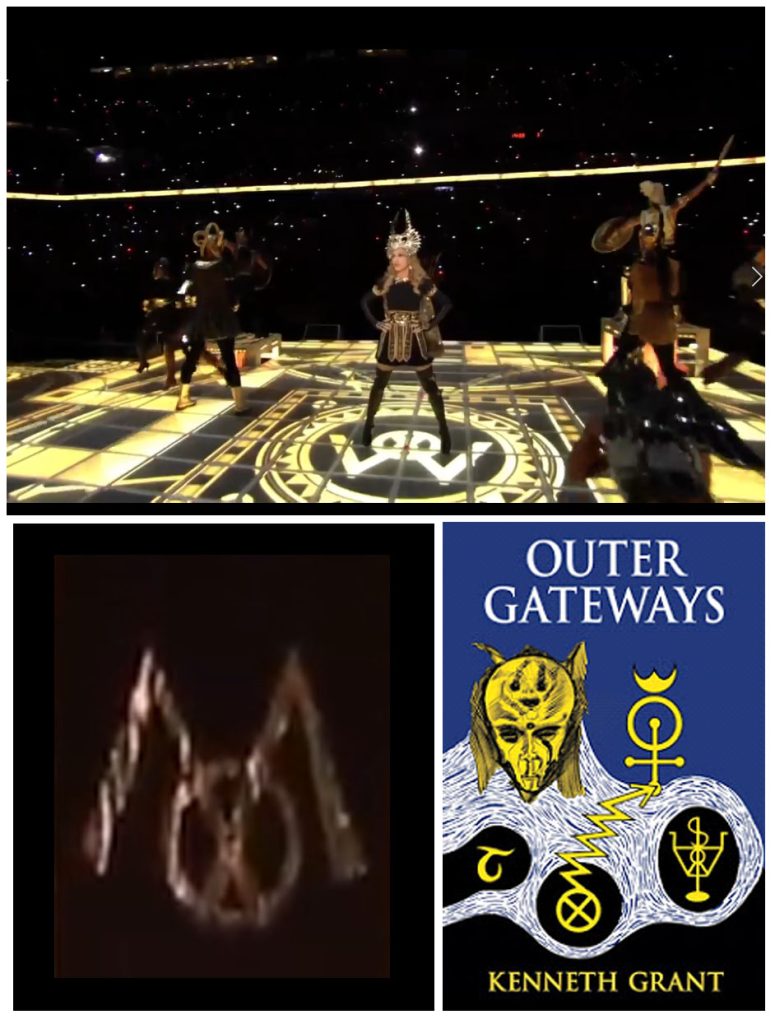
Then there is the 2012 Madonna symbol. Madonna recently had strange [social-media] diary posts about the Covid quarantines, describing it as ‘the great equaliser.’ The pop singer has a net value of 600 million dollars and probably chose the wrong word for her reference. Use the phrase atomiser instead. The symbol used in the ritualised Super Bowl half-time event seems to depict the letter M intersected with the X symbol – she stands above the symbol, above the sacred centre, with the letter M standing in for wings. The letter M also means mother-goddess-[scarlet or anti-Venus] – it’s also a zig-zag depiction. In Kenneth Grant’s book cover, the zig-zag depicts contact with daemons. I’m not saying there is an association, merely pointing out that in the early ’60s, some celebrities were deeply fixated on Crowley’s world, which Kenneth Grant was a student of. And Madonna is no stranger to kabbalah.
Sages may condemn using images to perceive the nature of being as it may lean towards idolatry, and denying it becomes iconoclasm because thought images manifest language into matter. Ironically, it’s the iconoclasts with their imperative disdain to consciously negate the image that put forward the image’s actual value. Much the same way Atheists dissected the Bible to prove to the world its inherent fallacy (one of those fallacies – which truthers are on board with – is the Bible having been re-written by the Catholic Church), and in doing so, give themselves more of an understanding for the transcendental than your average Christians, Atheists only being limited by their passive role and nihilism.
Researchers that sway towards an Esoteric-Christian-Movement but do not inherently define themselves with such a label have pointed out (in a post-Zeitgeist world) that Jesus was not hung on a cross but hung in a tree – the image of that is illustrated in the Arcana cards. It is also stated in Deuteronomy chapter 21-23 that the punishment for sin is worthy of death and is to be hung from a tree. However, what is not in scripture (this includes the Torah and Old Testament) is any mention of being hung on a cross; I guess you could say these are some of the first transcribed fake news/hoaxes that can be validated.
.
.

